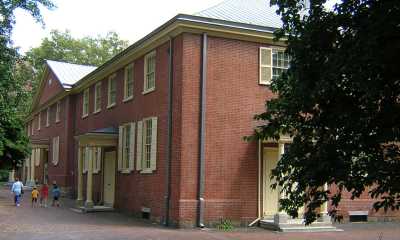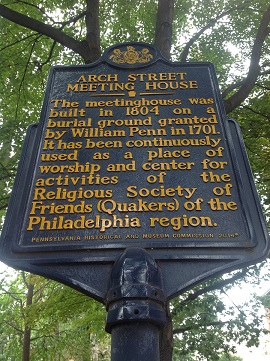Arch Street Friends Meeting House

"Let there be sacred silence" (Horace 23 B.C.)
Upon entering this Meeting House for the first time, a visitor unfamiliar with Quaker practices beholds a room with no pulpit; sunbeams rolling in but not through stained-glass windows; no religious icons hanging from the walls; no shrines are to be found at all. Instead, one steps into a great, square room filled with row after row of wooden pews, from all sides facing the center. A balcony supported by Doric columns spans three sides of the room. Plain are the windows and shutters; the floor is of unvarnished wood.
Dominant colors: brown, white. Simple. Silent.
QUAKERS AND PRAYER
Quakers, also known as the Society of Friends, have no written creed or fixed tenets of belief and no defined program of prayer. Music and sermonizing are absent during Worship Meetings. Further, Worship Meetings do not have a person in charge. Rather, Friends believe that God resides in each individual. Congregants enter the Meeting Room and settle down in silent waiting. Any Friend who feels the "light" may share a message or prayer with others. In this room one is reminded of the words of the poet Marianne Moore, "The deepest feeling always shows itself in silence."
THE BUILDING
This is the oldest Friends Meeting House still in use in Philadelphia and the largest in the world. It was built in 1804 and enlarged in 1811. The Philadelphia Yearly Meeting of Friends living in Philadelphia, the southern half of New Jersey, Delaware and parts of Maryland is held here every spring. Monthly business meetings are also conducted here — as they have since the 19th century.
The Meeting House has an entrance hall and three distinct sections. The West Wing, added in 1811 to accommodate the women's Monthly Meeting, is today the room used for worship as described above. Notice the two staircases leading to the balcony. Once upon a time young Quaker boys would use one set of stairs and young Quaker girls the other set. A "modesty board," a long piece of wood about four inches in height, runs the length of the staircase on the girl's side. This discouraged precocious Quaker lasses from showing too much leg to the curious eyes of the Quaker lads climbing on the other side. (Note that modesty boards were used in many 19th-century churches, by all denominations.)
The Meeting House's middle section serves as the site of Monthly Meetings and special events. In the East Wing of the building there are dioramas depicting the main events in the life of illustrious Quaker William Penn. Emphasized are seminal events in Penn's life, showing that the legacy of Philadelphia's founder belongs not only to Quaker City residents, but to the world. Depicted are Penn the Peacemaker laying down his sword (1668); Penn the Defender of Liberties in prison (1670); Penn the Builder of Democracy writing his "Frame of Government" (1682); Penn the Friend of the Indians completing a treaty with a tribe (1682); Penn the City Planner with his surveyor Thomas Holme, studying Holme's map (1683); and Penn the Founder of Schools (1699).
Also on display is a dollhouse representing the home of noted Quaker journal-keeper Elizabeth Drinker and her husband Henry. When reading Drinker's diary (kept from 1759-1807), one feels like a dinner guest in the home of an elite Quaker family. All manner of affairs are discussed from the scarcity of good servants to the transgressions Friends suffered during the Revolutionary War. Special shows are also held in the East Wing.
The ground around the Meeting House was first used for burial purposes under a patent issued by William Penn in 1701 and many victims of the yellow fever epidemic of 1793 are buried here. Burials continued until 1803, and the Meeting House was erected the following year. Certain burial exceptions were made for dignitaries such as Charles Brockden Brown (1771-1810), the first American novelist (Wieland), who rests here. Quaker Samuel Nicholas, the founder of the Marine Corps, is also buried here, which is curious considering the pacific stance of Friends. James Logan (1674-1751), secretary to William Penn, and along with Penn and Benjamin Franklin one of the three most important men in Philadelphia's Colonial period, lies here in an unmarked grave.
In front of the entrance to the Meeting House on Arch Street, is a memento to an equine time. A horse trough, fabricated by the Philadelphia Fountain Society, Instituted A.D. 1869, and "Presented by a Lady," expresses a horse's thirsty petition, "Give Us Water That We May Drink." This particular trough once stood in front of Independence Hall. During Independence Park's refurbishing, the trough on Arch Street was deemed superior and traded for the one which stood in front of the Hall.
- This Quaker meeting house is the oldest in Philadelphia and the largest in the world.
- The Meeting House's land was donated by William Penn.
- Charles Brockden Brown (1771-1810), the first American novelist is buried here.
- The noted abolitionist Lucretia Mott was a member of this meeting for a time.
- Edward Hicks, painter of The Peaceable Kingdom, attended the Yearly Meeting here. His cousin, Elias Hicks, lent his name to the Hicksites during the Quaker "Great Separation" of 1827.
- Location: 320 Arch Street between 3rd and 4th (map of Historic Philadelphia)
- Built: 1804
- Architect: Owen Biddle
- Tourism information: See the Arch Street Meeting House Website for visitor information. Donation requested.




